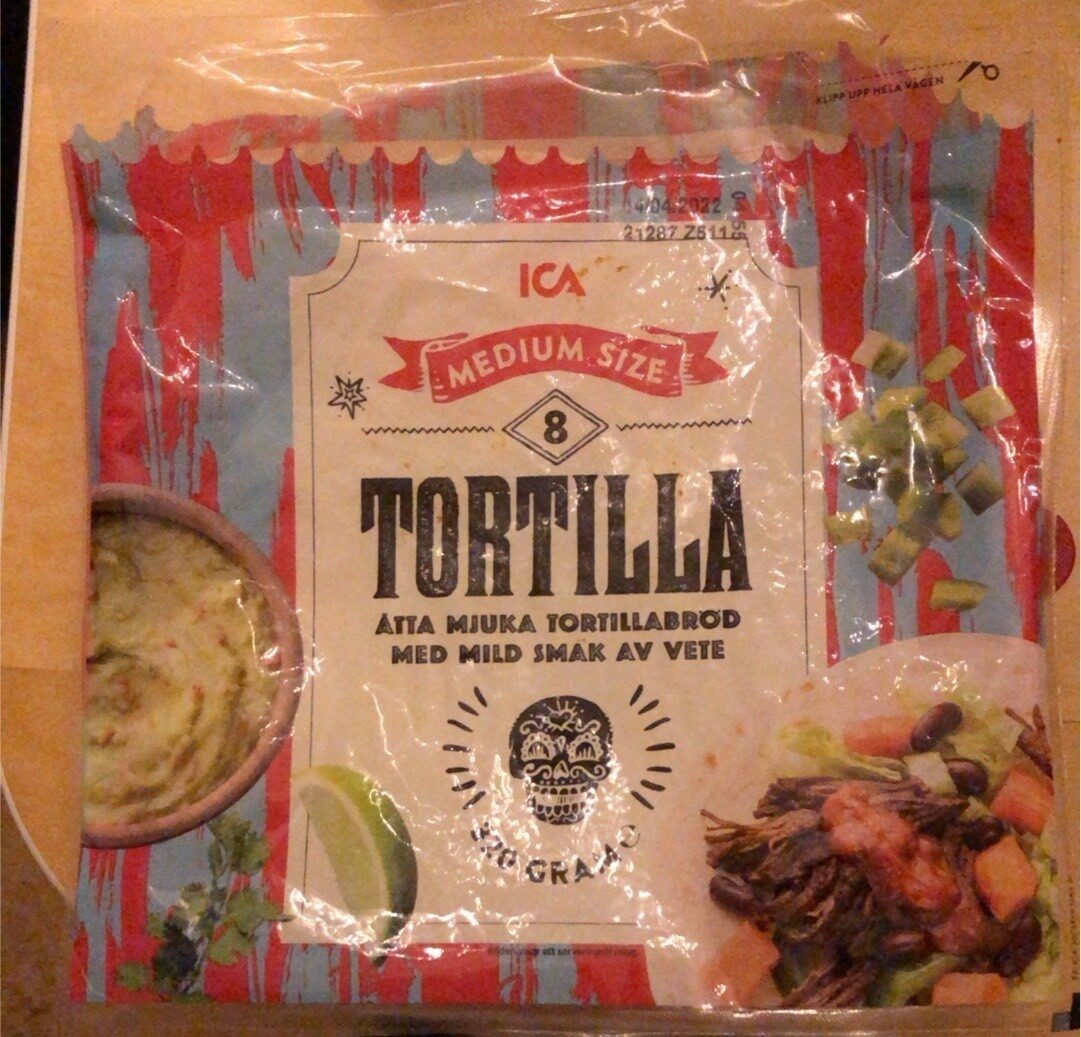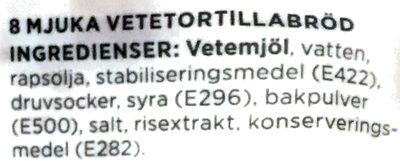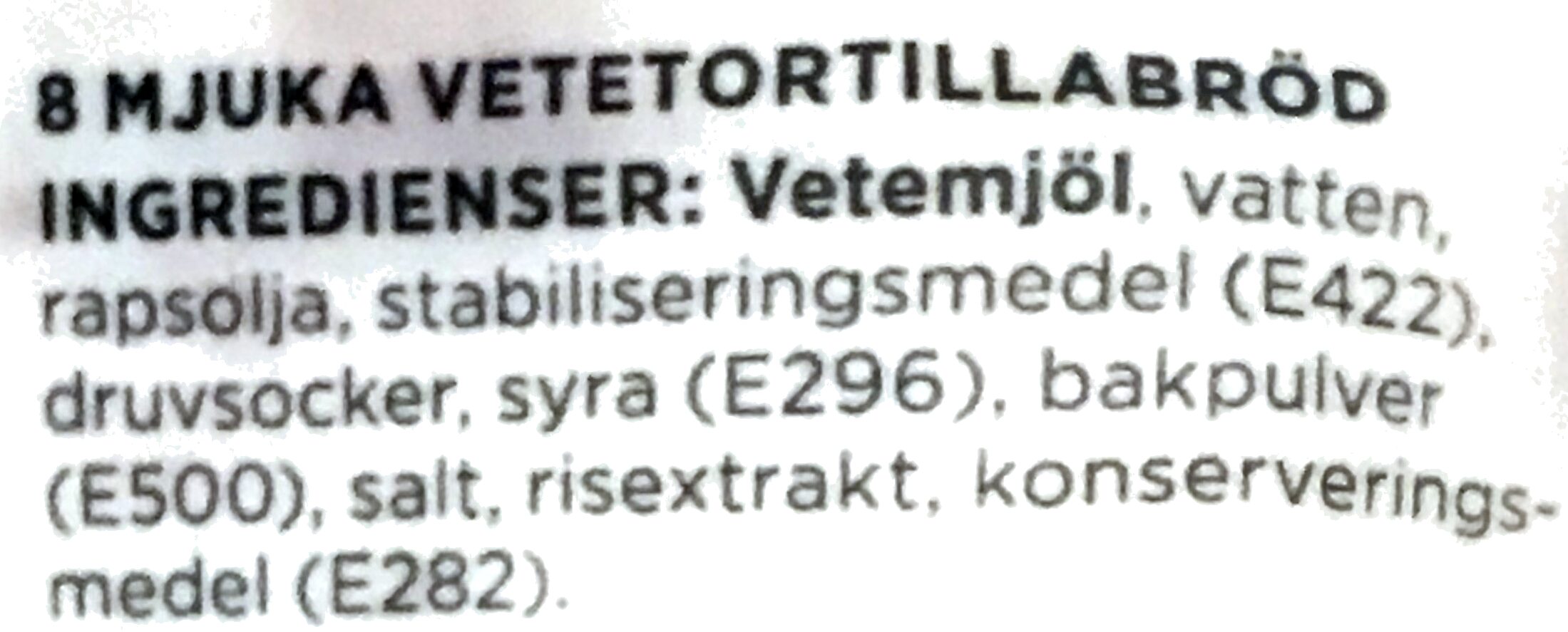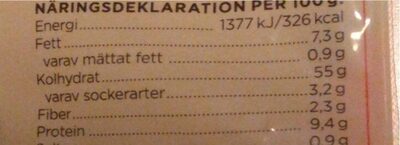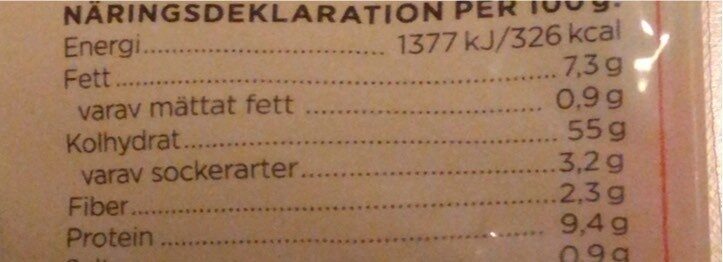Help us make food transparency the norm!
As a non-profit organization, we depend on your donations to continue informing consumers around the world about what they eat.
The food revolution starts with you!
Tortilla - Ica - 320g
Tortilla - Ica - 320g
This product page is not complete. You can help to complete it by editing it and adding more data from the photos we have, or by taking more photos using the app for Android or iPhone/iPad. Thank you!
×
Streckkod: 7318690035879 (EAN / EAN-13)
Kvantitet: 320g
Förpackning: Plast
Varumärken: Ica
Kategorier: Växtbaserad mat och dryck, Växtbaserad mat, Spannmål och Potatisar, Bröd, en:Flatbreads, en:White breads, en:Wheat breads, Halvtjockkakor
Tillverknings eller bearbetningsplats: Belgien
Länder där såld: Sverige
Matching with your preferences
Hälsa
Ingredienser
-
14 ingredienser
Vetemjöl, vatten. rapsolja, stabiliseringsmedel (E422), druvsocker, syra (E296), bakpulver (E500), salt, risextrakt, konserveringsmedel (E282).Allergener: Gluten
Food processing
-
Ultra processed foods
Elements that indicate the product is in the 4 - Ultra bearbetade livsmedel och drycker group:
- Tillsats: E422 - Glycerol
Food products are classified into 4 groups according to their degree of processing:
- Obearbetade eller minimalt bearbetade livsmedel
- Bearbetade kulinariska ingredienser
- Halvfabrikat
- Ultra processed foods
The determination of the group is based on the category of the product and on the ingredients it contains.
Tillsatser
-
E282 - Kalciumpropionat
Calcium propanoate: Calcium propanoate or calcium propionate has the formula Ca-C2H5COO-2. It is the calcium salt of propanoic acid.Källa: Wikipedia (Engelska)
-
E296 - Äppelsyra
Malic acid: Malic acid is an organic compound with the molecular formula C4H6O5. It is a dicarboxylic acid that is made by all living organisms, contributes to the pleasantly sour taste of fruits, and is used as a food additive. Malic acid has two stereoisomeric forms -L- and D-enantiomers-, though only the L-isomer exists naturally. The salts and esters of malic acid are known as malates. The malate anion is an intermediate in the citric acid cycle.Källa: Wikipedia (Engelska)
-
E422 - Glycerol
Glycerol: Glycerol -; also called glycerine or glycerin; see spelling differences- is a simple polyol compound. It is a colorless, odorless, viscous liquid that is sweet-tasting and non-toxic. The glycerol backbone is found in all lipids known as triglycerides. It is widely used in the food industry as a sweetener and humectant and in pharmaceutical formulations. Glycerol has three hydroxyl groups that are responsible for its solubility in water and its hygroscopic nature.Källa: Wikipedia (Engelska)
-
E500 - Natriumkarbonater
Sodium carbonate: Sodium carbonate, Na2CO3, -also known as washing soda, soda ash and soda crystals, and in the monohydrate form as crystal carbonate- is the water-soluble sodium salt of carbonic acid. It most commonly occurs as a crystalline decahydrate, which readily effloresces to form a white powder, the monohydrate. Pure sodium carbonate is a white, odorless powder that is hygroscopic -absorbs moisture from the air-. It has a strongly alkaline taste, and forms a moderately basic solution in water. Sodium carbonate is well known domestically for its everyday use as a water softener. Historically it was extracted from the ashes of plants growing in sodium-rich soils, such as vegetation from the Middle East, kelp from Scotland and seaweed from Spain. Because the ashes of these sodium-rich plants were noticeably different from ashes of timber -used to create potash-, they became known as "soda ash". It is synthetically produced in large quantities from salt -sodium chloride- and limestone by a method known as the Solvay process. The manufacture of glass is one of the most important uses of sodium carbonate. Sodium carbonate acts as a flux for silica, lowering the melting point of the mixture to something achievable without special materials. This "soda glass" is mildly water-soluble, so some calcium carbonate is added to the melt mixture to make the glass produced insoluble. This type of glass is known as soda lime glass: "soda" for the sodium carbonate and "lime" for the calcium carbonate. Soda lime glass has been the most common form of glass for centuries. Sodium carbonate is also used as a relatively strong base in various settings. For example, it is used as a pH regulator to maintain stable alkaline conditions necessary for the action of the majority of photographic film developing agents. It acts as an alkali because when dissolved in water, it dissociates into the weak acid: carbonic acid and the strong alkali: sodium hydroxide. This gives sodium carbonate in solution the ability to attack metals such as aluminium with the release of hydrogen gas.It is a common additive in swimming pools used to raise the pH which can be lowered by chlorine tablets and other additives which contain acids. In cooking, it is sometimes used in place of sodium hydroxide for lyeing, especially with German pretzels and lye rolls. These dishes are treated with a solution of an alkaline substance to change the pH of the surface of the food and improve browning. In taxidermy, sodium carbonate added to boiling water will remove flesh from the bones of animal carcasses for trophy mounting or educational display. In chemistry, it is often used as an electrolyte. Electrolytes are usually salt-based, and sodium carbonate acts as a very good conductor in the process of electrolysis. In addition, unlike chloride ions, which form chlorine gas, carbonate ions are not corrosive to the anodes. It is also used as a primary standard for acid-base titrations because it is solid and air-stable, making it easy to weigh accurately.Källa: Wikipedia (Engelska)
Ingrediensanalys
-
Palmoljefri
No ingredients containing palm oil detected
-
Vegansk status okänd
Okända ingredienser: Druvsocker
-
Vegetarisk status okänd
Okända ingredienser: Druvsocker
-
Details of the analysis of the ingredients
: _Vetemjöl_, vatten, rapsolja, stabiliseringsmedel (e422), druvsocker, syra (e296), bakpulver (e500), salt, risextrakt, konserveringsmedel (e282)- _Vetemjöl_ -> en:wheat-flour - vegan: yes - vegetarian: yes - ciqual_proxy_food_code: 9410 - percent_min: 10 - percent_max: 100
- vatten -> en:water - vegan: yes - vegetarian: yes - ciqual_food_code: 18066 - percent_min: 0 - percent_max: 50
- rapsolja -> en:rapeseed-oil - vegan: yes - vegetarian: yes - from_palm_oil: no - percent_min: 0 - percent_max: 33.3333333333333
- stabiliseringsmedel -> en:stabiliser - percent_min: 0 - percent_max: 25
- e422 -> en:e422 - vegan: maybe - vegetarian: maybe - percent_min: 0 - percent_max: 25
- druvsocker -> en:grape-sugar - percent_min: 0 - percent_max: 20
- syra -> en:acid - percent_min: 0 - percent_max: 16.6666666666667
- e296 -> en:e296 - vegan: yes - vegetarian: yes - percent_min: 0 - percent_max: 16.6666666666667
- bakpulver -> en:baking-powder - vegan: yes - vegetarian: yes - ciqual_food_code: 11046 - percent_min: 0 - percent_max: 14.2857142857143
- e500 -> en:e500 - vegan: yes - vegetarian: yes - percent_min: 0 - percent_max: 14.2857142857143
- salt -> en:salt - vegan: yes - vegetarian: yes - ciqual_food_code: 11058 - percent_min: 0 - percent_max: 0.9
- risextrakt -> en:rice-extract - vegan: yes - vegetarian: yes - ciqual_proxy_food_code: 9100 - percent_min: 0 - percent_max: 0.9
- konserveringsmedel -> en:preservative - percent_min: 0 - percent_max: 0.9
- e282 -> en:e282 - vegan: yes - vegetarian: yes - percent_min: 0 - percent_max: 0.9
Näring
-
Good nutritional quality
⚠ ️Warning: the amount of fruits, vegetables and nuts is not specified on the label, it was estimated from the list of ingredients: 11This product is not considered a beverage for the calculation of the Nutri-Score.
Positiva poäng: 7
- Proteiner: 5 / 5 (värde: 9.4, avrundat värde: 9.4)
- Fiber: 2 / 5 (värde: 2.3, avrundat värde: 2.3)
- Frukt, grönsaker, nötter och raps- / valnöt- / olivoljor: 0 / 5 (värde: 11.25, avrundat värde: 11.3)
Negativa poäng: 7
- Energi: 4 / 10 (värde: 1400, avrundat värde: 1400)
- Socker: 0 / 10 (värde: 3.5, avrundat värde: 3.5)
- Mättat fett: 0 / 10 (värde: 0.9, avrundat värde: 0.9)
- Natrium: 3 / 10 (värde: 360, avrundat värde: 360)
The points for proteins are counted because the negative points are less than 11.
Näringsvärde: (7 - 7)
Nutri-Score:
-
Näringsvärden
-
Fett i måttlig kvantitet (7.3%)
What you need to know- A high consumption of fat, especially saturated fats, can raise cholesterol, which increases the risk of heart diseases.
Recommendation: Limit the consumption of fat and saturated fat- Choose products with lower fat and saturated fat content.
-
Mättat fett i låg kvantitet (0.9%)
What you need to know- A high consumption of fat, especially saturated fats, can raise cholesterol, which increases the risk of heart diseases.
Recommendation: Limit the consumption of fat and saturated fat- Choose products with lower fat and saturated fat content.
-
Sockerarter i låg kvantitet (3.5%)
What you need to know- A high consumption of sugar can cause weight gain and tooth decay. It also augments the risk of type 2 diabetes and cardio-vascular diseases.
Recommendation: Limit the consumption of sugar and sugary drinks- Sugary drinks (such as sodas, fruit beverages, and fruit juices and nectars) should be limited as much as possible (no more than 1 glass a day).
- Choose products with lower sugar content and reduce the consumption of products with added sugars.
-
Salt i måttlig kvantitet (0.9%)
What you need to know- A high consumption of salt (or sodium) can cause raised blood pressure, which can increase the risk of heart disease and stroke.
- Many people who have high blood pressure do not know it, as there are often no symptoms.
- Most people consume too much salt (on average 9 to 12 grams per day), around twice the recommended maximum level of intake.
Recommendation: Limit the consumption of salt and salted food- Reduce the quantity of salt used when cooking, and don't salt again at the table.
- Limit the consumption of salty snacks and choose products with lower salt content.
-
-
Näringsfakta
Näringsfakta Som såld
för 100 g / 100 mlCompared to: en:White breads Energi 1 400 kj
(326 kcal)+21 % Fett 7,3 g +70 % Mättat fett 0,9 g +24 % Kolhydrat 55 g +12 % Sockerarter 3,5 g +36 % Fiber 2,3 g −2 % Protein 9,4 g +13 % Salt 0,9 g - Fruits‚ vegetables‚ nuts and rapeseed‚ walnut and olive oils (estimate from ingredients list analysis) 11,25 %
Miljö
-
Eco-Score B - Låg miljöpåverkan
The Eco-Score is an experimental score that summarizes the environmental impacts of food products.→ The Eco-Score was initially developped for France and it is being extended to other European countries. The Eco-Score formula is subject to change as it is regularly improved to make it more precise and better suited to each country.Life cycle analysis
-
Average impact of products of the same category: A (Score: 93/100)
Kategori: Wheat tortilla wrap, to be filled
Kategori: Wheat tortilla wrap, to be filled
- PEF environmental score: 0.16 (the lower the score, the lower the impact)
- including impact on climate change: 1.20 kg CO2 eq/kg of product
Stage Impact Jordbruk
54.7 %Bearbetar
23.7 %Förpackning
14.5 %Transportation
6.6 %Distribution
0.5 %Consumption
0.0 %
Bonuses and maluses
-
Missing origins of ingredients information
Malus: -5
⚠ ️ The origins of the ingredients of this product are not indicated.
If they are indicated on the packaging, you can modify the product sheet and add them.
If you are the manufacturer of this product, you can send us the information with our free platform for producers.
-
Packaging with a medium impact
Malus: -10
Form Material Återvinning Impact Okänd Plast Hög ⚠ ️ The information about the packaging of this product is not sufficiently precise (exact shapes and materials of all components of the packaging).⚠ ️ For a more precise calculation of the Eco-Score, you can modify the product page and add them.
If you are the manufacturer of this product, you can send us the information with our free platform for producers.
Eco-Score for this product
-
Impact for this product: B (Score: 78/100)
Produkt: Tortilla - Ica - 320g
Life cycle analysis score: 93
Sum of bonuses and maluses: -15
Final score: 78/100
-
Carbon footprint
-
Equal to driving 0.6 km in a petrol car
120 g CO² per 100g of product
The carbon emission figure comes from ADEME's Agribalyse database, for the category: Wheat tortilla wrap, to be filled (Source: ADEME Agribalyse Database)
Stage Impact Jordbruk
48.0 %Bearbetar
17.1 %Förpackning
23.5 %Transportation
11.0 %Distribution
0.4 %Consumption
0.0 %
Förpackning
-
Packaging with a medium impact
-
Packaging parts
(Plast)
-
Packaging materials
Material % Packaging weight Packaging weight per 100 g of product Plast
-
Transportation
-
Origins of ingredients
Missing origins of ingredients information
⚠ ️ The origins of the ingredients of this product are not indicated.
If they are indicated on the packaging, you can modify the product sheet and add them.
If you are the manufacturer of this product, you can send us the information with our free platform for producers.Add the origins of ingredients for this product Add the origins of ingredients for this product
Report a problem
-
Incomplete or incorrect information?
Category, labels, ingredients, allergens, nutritional information, photos etc.
If the information does not match the information on the packaging, please complete or correct it. Open Food Facts is a collaborative database, and every contribution is useful for all.
Datakällor
Produkt tillagd den av dahlqvist
Senast ändrad produktsida på av packbot.
Produktsida också redigerad av date-limite-app, ecoscore-impact-estimator, kiliweb, musarana, yuka.sY2b0xO6T85zoF3NwEKvllZWCYD__hLWDwXfsGKI6PuIJ7v1a4xO_ZbGGKs.

